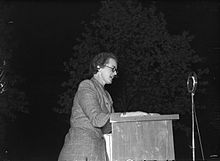Squeegee Seweriin
Rakel Solberg Seweriin (born June 26, 1906 in Hof , today Holmestrand , † September 17, 1995 in Oslo ) was a Norwegian politician of the Arbeiderpartiet (Ap). From 1953 to 1955 she was the social minister of her country.
Origin and education
Seweriin grew up with her parents in Eidsfoss . Her mother Zefra Eliagna Natterstad, who came from a political household and who always had her own income from running a railway hotel, attached great importance to the education of her daughters. Rakel, for example, was one of the few women who achieved university entrance qualification in the 1920s.
After finishing school, Rakel Seweriin went to Oslo, where she trained as a stenographer in the Norwegian parliament, the Storting , from 1927 . During this time she also worked as a domestic help to finance the training. In 1930 she took a course in English and German shorthand.
Political engagement and escape to London
During her apprenticeship, she began to get involved politically in the labor movement. She was a member of the youth organization of the Labor Party, the Arbeidernes Ungdomsfylking (AUF). From 1929 she worked as a stenographer. In 1932 she married the teacher and journalist Ernst Samuel Sørensen, but the marriage was later dissolved. In 1937 she moved to the Oslo City Council, where she remained a member of parliament until 1940. In 1937 she married the doctor Alf Seweriin (1909–1961). In addition, she became vice-chairwoman of the AUF that year.
After the outbreak of the Second World War , she and her husband were active in the resistance movement. Because of this, the two had to flee to London in 1942 . The Norwegian government-in-exile was staying there at this time and she began to work as a stenographer for the top military. During this time she was also a member of the Norwegian Women's Committee in London.
Stortings MP and Minister of Social Affairs
After her return to Norway, Seweriin moved into the Norwegian parliament, the Storting, for the first time in 1945. After she was deputy chairman of the Social Committee from 1945 to 1950, she headed this body until 1953. Thus she was the first woman in her party to head a parliamentary committee. From 1945 she was also involved in the women's group of the Arbeiderpartiet, of which she was chairman between 1953 and 1963.
On November 2, 1953, she was appointed Minister of Social Affairs in the Torp government, after her party colleague Aaslaug Aasland resigned from this office. During her tenure, Seweriin campaigned, among other things, for more married women to work. After the change of government on January 22, 1955, she initially remained Minister of Social Affairs in the Gerhardsen III government . However, her relationship with Minister of State Einar Gerhardsen was strained and she later testified that Gerhardsen was not interested in women's affairs and would not let her get a chance. Severiin subsequently left the government on August 1, 1955.
She then returned to Storting as a member of parliament, where she was employed from 1958 as deputy chairwoman of the Church and Education Committee. Overall, she remained a member of parliament until 1969 after she refused to run again for election. Seweriin became one of the most influential women in Norwegian politics after World War II through her long time as MP and Minister of Social Affairs.
Web links
- Rakel Seweriin in the Norsk biografisk leksikon (Norwegian)
- Squeegee Seweriin at Storting (Norwegian)
- Squeegee Seweriin in the store norske leksikon (Norwegian)
Individual evidence
- ↑ Squeegee Seweriin: Fra Eidsfoss stasjon til Kongens bord. Vestfold Museene, accessed December 17, 2019 (Norwegian).
| personal data | |
|---|---|
| SURNAME | Seweriin, squeegee |
| ALTERNATIVE NAMES | Seweriin, Rakel Solberg (full name); Solberg, Rakel (maiden name) |
| BRIEF DESCRIPTION | Norwegian politician |
| DATE OF BIRTH | June 26, 1906 |
| PLACE OF BIRTH | Hof , Holmestrand |
| DATE OF DEATH | 17th September 1995 |
| Place of death | Oslo |
